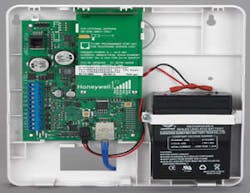Honeywell's GSM Communicator Responds to AMPS Sunset, Cell-Only Needs
SYOSSET, N.Y., Sept. 14, 2006 – Honeywell today introduced the alarm industry’s first line of Global System for Mobile (GSM) Communications technology products that use dual and triple communication paths to maximize reliability of alarm transmission and delivery. The platform also enables customers to take advantage of emerging capabilities, such as the ability to control Honeywell alarm systems remotely through laptops, PDAs and even cell phones.
The end-to-end solution will help transition users to the latest digital technology as current alarm radios that use analog Advanced Mobile Phone Services (AMPS) networks are phased out. Already dwindling, the use of analog systems is expected to further decline after Feb. 18, 2008, the date on which the Federal Communications Commission (FCC) has said cellular carriers may discontinue support of the AMPS networks—known commonly as the Sunset Clause.
“These products not only offer customers the latest advancements in alarm technology, they offer a complete, long-term solution to challenges presented by the Sunset Clause, Voice over Internet Protocol (VoIP) and premises without telephone lines,†said Ron Rothman, president of Honeywell Security and Custom Electronics. “The communication system used by these products makes them more reliable and upgradeable, offering greater flexibility and ease of use. It’s supported by our state-of-the-art AlarmNet backbone, the industry’s premier alarm communications system.â€
Customers who use existing Honeywell radios can have their equipment easily upgraded to the newest GSM GPRS technology. The dual-path technology (7845GSM) utilizes Short Message Service (SMS) as the backup communication path to General Packet Radio Service (GPRS), a wireless data service widely used in the cell phone market and now available with almost every GSM network. GPRS is a connectivity solution that supports a wide range of enterprise and consumer applications. It has a higher priority in the cellular network to minimize transmission delays and increases the amount of data that can be reliably delivered. Honeywell also offers a triple-path technology radio (the 7845i-GSM) that uses secure, wireless Internet communication in addition to the GRPS and SMS signals.
The communication technology allows for several new, user-friendly alarm capabilities. For instance, customers can have dealers upload and download software updates for the Honeywell control panels using wireless communications or the Internet, eliminating or reducing the need for scheduled technician visits. It also enables users to control an alarm system through cell phone text messages, a laptop computer or a Web-enabled PDA. Finally, the radio’s modular design ensures that should the technology change in the future, a small radio-only board can be installed to replace the existing one without physically removing and rewiring the entire radio, saving customers time and money.
Honeywell’s GSM GPRS radios come standard with a power supply and rechargeable battery capable of providing 24-hour backup.
“Technology is constantly evolving, and Honeywell’s new GSM GPRS technology offers customers a platform that can be built on,†said Rothman. “We have designed our GSM GPRS solution with the future in mind.â€
For more information, please visit www.security.honeywell.com.
